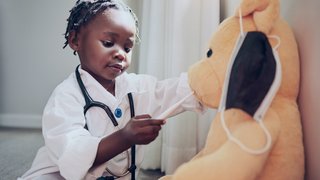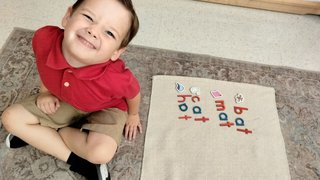5 common childhood injuries and how to prevent them
December 22, 2023

As children and teens learn to navigate the world, it’s inevitable they will get hurt from time to time. Scrapes, bumps, and bruises are just part of growing up. And, as much as we might like to put our kids in “bubble wrap” until they reach adulthood, we simply can’t protect them from everything.
That said, there are some common-sense steps parents, communities, and providers can take to prevent and reduce the risk of severe childhood injuries, such as car and bike accidents, falls, sports injuries, and animal bites.
Unintentional injuries are the leading cause of death in children ages 1 to 14. While that fact might surprise some people, specialists at UT Southwestern Pediatric Surgery treat hundreds of kids each year for serious injuries ranging from poisonings and burns to gunshot wounds and playground falls. Many of these injuries could have been avoided with safety reminders and precautions, such as wearing a seat belt or helmet or locking up a firearm.
As providers and prevention advocates, we look at unintentional childhood injury as a disease – but one that often can be prevented.
Pediatric injury rates have declined in the last two decades, due in large part to research-driven public safety initiatives and injury-prevention guidelines that have helped increase awareness. And yet, many of these are still taken for granted. A closer look at five of the most common childhood injuries can provide a road map to better prevention and protecting more kids.
1. Falls
Falls are the leading reason for a child in the U.S. to be taken to the hospital. The same is true in Texas, with 45% of pediatric nonfatal injuries resulting from falls. Data from Children’s Health shows that falls are the leading cause of nonfatal pediatric injuries in Dallas-Fort Worth and Plano.

Falls typically happen at home in younger kids, with accidents on stairs or out of windows. For elementary school kids, tumbles off playground equipment or bikes are common causes.
Baby gates approved by the U.S. Consumer Product Safety Commission (CPSC) are required to withstand at least 30 pounds of push-out pressure when properly installed. Gates installed using suction wall cups must include warning labels about proper installation, and pressure-mounted gates are required to give visual side-pressure feedback on proper installation.
Along with baby gates, recommendations call for using the safety belt on strollers, highchairs, and changing tables to prevent falls in infants and toddlers. Keep furniture away from windows and install window locks and window guards. Data from the government of New York City found that required installation of window guards reduced annual window fall-related deaths in children by 80%.
Playground accidents can lead to falls that result in fractures, sprains, and concussions. Help children understand the rules of the playground and how to safely navigate the equipment, as well as the importance of seeking help from an adult. Also, try to make sure the playground equipment is in good condition before allowing your child to play on it.
When it comes to young children, adults may not suspect a fracture right away due to limited swelling or ability to move the limb or bear weight. If a child falls and complains of pain, nausea, tingling, or weakness in the limb, or if you see swelling or deformity in the injured area, get them checked out by a medical professional right away.

Choosing a car seat
Use a rear-facing car seat from birth until ages 2-4.
Use a forward-facing car seat until at least age 5.
Use a booster seat until your child is big enough to fit in a seat belt.
Keep children properly buckled in the back seat until age 12.
2. Motor vehicle accidents
Improperly used car seats and seat belts account for many of the pediatric injuries related to motor vehicle collisions, which are among the leading causes of fatal childhood injuries nationally and in the greater Dallas area.
The U.S. Department of Transportation’s National Highway Traffic Safety Administration found that while most parents and caregivers are confident they have properly installed their child’s car seat, 46% have been installed incorrectly. Carefully follow the instructions to install your child’s car seat using the anchor hooks and seat belts in your vehicle. To check your installation, schedule a car seat check at Children’s Health.
Teach your children to wear a seat belt every time they get in a vehicle, no matter where they sit. I just had this conversation again recently with my teenage son. During a car accident, unbuckled people in the back seat keep moving forward at the speed of the impact. They will likely be ejected from the car, which significantly lowers the chance of survival. On the way forward, they will smash into the people in the front seat, putting their friends at risk of serious injury or death. And parents, always wear your seat belt, since kids model their behavior after you.
Also, remind your teens that airbags alone are not enough to protect someone in an accident. Airbags inflate to soften the blow on impact, but a seat belt or properly installed car seat is what stops them from being expelled from the vehicle.
3. Animal bites
According to the American Veterinary Medical Association, children account for half the 4.5 million people who are bitten by an animal in the U.S. each year, and most bites are from an animal the child knows. Kids and animals are unpredictable by nature, so don’t leave young children alone with an animal – even if the animal has always been friendly.
Young children are more likely to be bitten in the face or head, followed by the upper extremities and lower body, and a 2022 study of five years of animal bite data found that 8% of children with bites needed surgical treatment. Teach your child a few basic rules to reduce the risk of getting bitten:
- Don’t tease an animal, play with it roughly, wake it up, bother it while it’s eating, or grab its toys or food.
- Don’t approach an unfamiliar dog without asking its owner. Some pets don’t tolerate children or might react aggressively if they’re surprised or threatened.
- Avoid contact with wild animals. It might feel heroic to try and help a stray dog, cat, or critter, but it’s best to leave the rescuing to professionals.
If your child is bitten, take them to the emergency room right away to reduce the risk of bleeding and infection. Give the providers as many details as you can, so the child gets the proper care. Withholding information to protect the animal is a risk that increases the chance it might happen again to your child or someone else’s.

Reducing injury risk
In March 2023, the American College of Surgeons Committee on Trauma updated its statement on bicycle safety, noting that wearing helmets can significantly reduce the risk of injury:
48% for head injuries
53% for traumatic brain injuries
23% for face injuries
34% for fatal injuries
4. Bike accidents
Bike accidents are the second most common pediatric injury in the Plano area and the fifth most common in the Metroplex. Wearing a helmet can significantly reduce the risk of injury.
Bike helmets look much cooler now than they did when they first came out, so hopefully you won’t have to do much convincing to get your child to strap one on – and keep it on.
The helmet should fit snugly but comfortably and sit level on the head, not tilted to the back or front and not wobbly in any direction. The chin strap should remain securely fastened and tight enough so you can slip only one finger between the strap and their skin.
Buy a helmet made specifically for biking. They are ventilated for comfortable riding and specifically designed to protect against bike-related head impact. Only choose a helmet that is labeled with the CPSC logo. That means it meets CPSC’s stringent bike helmet safety standards for the child’s age and potential impact injuries.
Teach your children the rules of the road. They should ride with the flow of traffic, preferably in a bike lane. Teach them proper hand signals to indicate left and right turns and remind them not to use AirPods or earbuds while riding. The same is true for walking near the road. Drivers may not always be on the lookout for kids where they’re driving, so teach your kids to be on high alert – watch for cars instead of expecting cars to watch for you.
In addition, make sure children have reflectors or flashing lights on their bikes and helmets if they’ll be riding in low-light hours, and give them a bell to alert pedestrians and other cyclists that they’re coming from behind.
5. Sports injuries
The trend of sports specialization, particularly in younger kids, has led to an increase in overuse and repetitive stress injuries for activities such as pitching, jumping, and running. In general, don’t let your kids spend more hours per week than their age playing sports to avoid overuse injuries.
Children should wear all recommended safety equipment, such as helmets, chest protectors, and pads. Even at a young age, technique is important – poor body mechanics for standing, jumping, and swinging will become habits that could lead to injury over time.
Teach kids and teens to warm up before and cool down after practice and games. Active stretching and light jogging in place will help prepare their muscles and joints for exercise and slowly bring down their heart rate after a workout.
Related reading: High school athletes’ most common injuries — and how to avoid them
Be a role model for safety
Children start learning from birth by watching the people around them. It’s important that parents and community members model safe behavior. Set and expect a culture of safety at home – for example, seat belts and bike helmets will be worn every time they get in a car or on a bike. This should be so ingrained in them that they will find it strange when they see other people not doing the same.
Involve them in their own safety by letting them pick out and decorate a CPSC-approved bike helmet. Giving them some autonomy provides more ownership over their own health. Talk with your children and ask what they’re thinking. You might be surprised at their logic for why they do or don’t take some of the safety precautions you expect.
It takes a village to keep children safe. By understanding how and where pediatric injuries are occurring, our communities can develop strategies and interventions to prevent them.
To visit with a doctor about your child’s health, call 214-645-8300 or request an appointment online.











